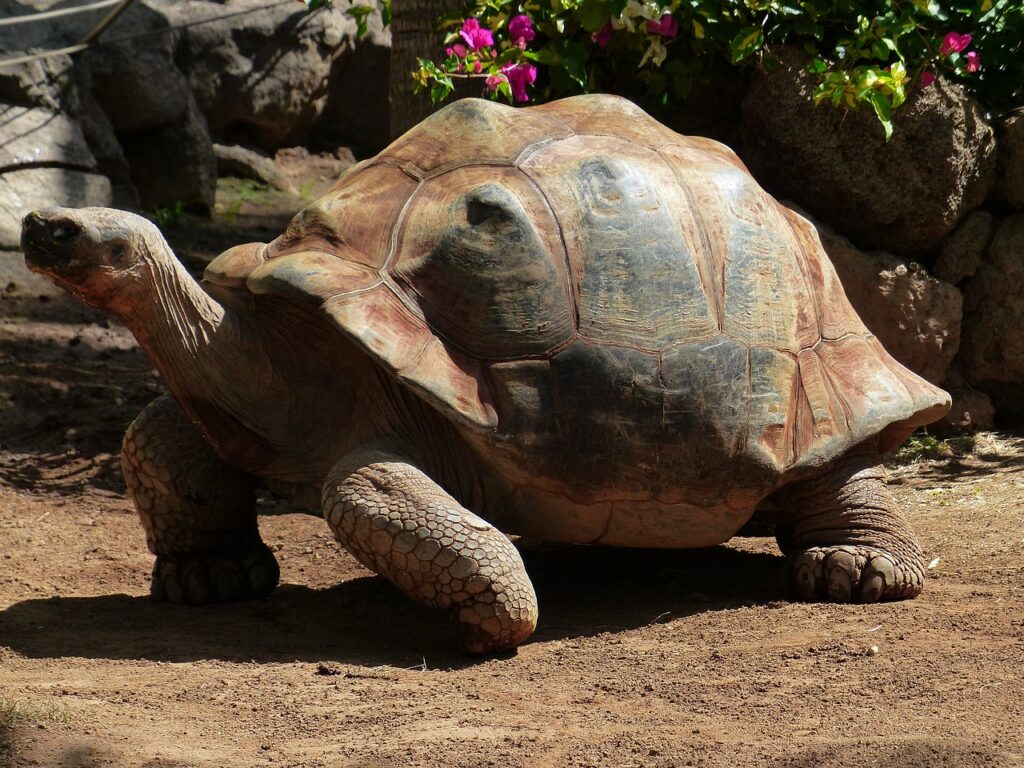Sulcata tortoises, also named African spurred tortoises, can get really big! They are the 3rd largest species of tortoise on the planet. Males can reach 30 inches long and weigh over 100 pounds. Their long lifespans and constant growth rate make them so big.
These gentle giants come from dry regions of Africa. They can go a long time without drinking water, thanks to their unique ability to store water. This helps them keep growing.
Sulcata tortoises can live to be over 70 years old. When young, they grow quickly and can double or triple in size each year. As they become adults, their growth slows down.
If you’re thinking of getting one as a pet, remember they need lots of space and a clean environment. They need room to move around and access to fresh water.
Pro Tip: Make sure you research before getting a Sulcata tortoise. They need special care, because of their size and specific needs. If they keep growing, we may need to build bigger houses and call them Tortoise Mansions!
Key Takeaways
- Sulcata tortoises can grow to be very large, with males reaching sizes of up to 30 inches in length and weighing over 100 pounds.
- These tortoises have a long lifespan, often living for 50 to 150 years.
- It is important to provide a suitable habitat for sulcata tortoises, as they require ample space to roam and graze.
- Proper diet is crucial for the health of these tortoises, with a focus on high-fiber foods such as grasses and leafy greens.
- Sulcata tortoises are not suitable pets for everyone, as their large size and long lifespan require a significant commitment of time, space, and resources.
Description of Sulcata Tortoises

To understand the description of Sulcata tortoises, explore their appearance and physical characteristics, as well as their natural habitat. Discover the distinct features that define these tortoises and gain insights into the environments they naturally occupy.
Appearance and Physical Characteristics
The Sulcata Tortoise has bewitching features and attributes. It’s known for its large size, shell patterns, and strong body. Let’s explore their look and characteristics.
Gaze upon the grand Sulcata Tortoise, a species that charms with its arresting physical qualities. Here’s a list of their special features:
| Physical Characteristics | Description |
|---|---|
| Size | These tortoises are one of the largest species. Adults are 24-30 inches long. Some may be even bigger. |
| Shell | Their shells have attractive patterns with raised scutes. The shape of their shells gives them protection and helps with movement. |
| Coloring | They have a tan to dark brown coloring on their shells, great for arid environments they live in. |
Sulcata Tortoises have heavy scales called “sulci” on their front legs. These scutes help them burrow and give them extra support on rough terrain.
Fun Fact: Did you know they’re native to sub-Saharan Africa?
They may seem slow, but they sprint when someone mentions the word ‘salad’!
Natural Habitat
Sulcata tortoises, known as African spurred tortoises, come from arid regions of the Sahara Desert’s south edge. They have a special habitat that lets them thrive in these tough conditions.
Countries like Mauritania, Sudan, and Nigeria are their homes. Dry grasslands, thorny scrub woods, and semi-deserts are where they prefer to live. Temperature in their environment usually gets scorching during the day and plunges at night.
Let’s get into the details of their natural habitat:
- Region: They mainly stay in the Sahel region of Africa, which has a transition between the Sahara Desert and savannah grasslands.
- Temperature: Sulcata tortoises handle high temperatures well. They spend most of their time soaking up the sun’s rays on roadsides or elevated spots with direct sunlight.
- Diet: These tortoises are herbivores and mostly eat grasses and leafy plants from their habitat. They have beak-like jaws that let them eat tough vegetation.
- Soil: Loose soil is perfect for sulcata tortoises to dig burrows. This hides them from rough weather and keeps them safe from predators.
- Water source: They can go without water for a long time, but they need access to rivers or seasonal ponds to drink.
So, make sure to get the right habitat for your pet sulcata tortoise! Research thoroughly and take advice from experts to give these amazing creatures the best home.
Factors Affecting the Size of Sulcata Tortoises
To understand the factors affecting the size of Sulcata Tortoises, delve into their genetics, diet and nutrition, and environmental conditions. Discover how these elements play a pivotal role in determining the ultimate size of these fascinating creatures.
Genetics
Table:
| Factor | Influence on Size |
|---|---|
| Genetic variations | Growth potential |
| Inheritance patterns | Offspring size |
| Gene expression levels | Body structure |
Genetics also control growth hormones in Sulcata Tortoises. A pair of these tortoises had a unique genetic makeup. Their offspring inherited the trait. They grew a lot bigger than other tortoises. This shows how genetics can make a big difference in size. The phrase ‘you are what you eat’ takes on a whole new meaning for sulcata tortoises. Seems they didn’t get the memo about portion control!
Diet and Nutrition
Sulcata Tortoises require a unique diet and nutrition for optimal growth and development. Plant matter such as grasses, leaves, and fruits form the most important part of their diet. They also need a high intake of calcium to build strong shells and bones. Vitamin D3 is essential too – it helps absorb calcium from their meals. Sunlight is key for synthesizing Vitamin D3. Plus, maintaining proper hydration is pivotal for overall health.
Without the right nutrition, these tortoises may suffer from deformities or stunted growth. So, ensure they have the right diet and optimal exposure to sunlight and water. Then, watch them grow ‘green with envy’!
Environmental Conditions
When it comes to Environmental Conditions, many things matter. Sunlight is key for tortoises. It helps them regulate their body temperature and absorb calcium, which is essential for a healthy shell. They also need just the right humidity levels; too little causes dehydration and slow growth.
Vegetation is another important factor. Sulcata Tortoises thrive on mostly grasses and hay. Different plants give them the nutrients they need. Fresh water for drinking and bathing is also vital.
Temperature affects their growth too. They need warm weather to stay active and digest food. Too cold or too hot can hurt their health and stunt growth.
It’s also important they have enough space in their enclosure. This encourages exercise, which supports muscle growth and size.
Finally, history tells us that environment influences size. Fossil records show prehistoric tortoises were bigger in environments with plenty of resources than in less favourable conditions.
Growth Stages of Sulcata Tortoises

To understand the growth stages of Sulcata tortoises, delve into the section “Growth Stages of Sulcata Tortoises.” This section explores the progression of hatchlings and juveniles, subadults, and adult size. Each sub-section sheds light on the unique characteristics and development of these stages.
Hatchlings and Juveniles
Hatchlings of Sulcata tortoises are tiny, only a few inches long, with soft and pliable shells providing little protection. To support their rapid growth, a warm and safe environment is essential, as well as a nutrient-rich diet. As they transition into juveniles, they grow in size and develop stronger shells.
To ensure the well-being of hatchlings and juveniles:
- Give them a suitable habitat with proper shelter and hiding spots.
- Monitor their health regularly and consult a reptile vet for any issues.
- Encourage exercise by providing ample space for them to build strength in their limbs.
These steps are necessary for the success of hatchlings and juveniles in becoming healthy adult Sulcata tortoises. A nurturing environment and responsible care are key factors in guaranteeing their well-being. Subadults are still growing, making them the gangly giants of the tortoise world.
Subadults
Meet Sheldon: a subadult Sulcata tortoise. He was rescued from an illegal pet trade and taken to a wildlife rehabilitation center. His size? 6-12 inches in carapace length, with an average yearly increase of 2-3 inches. His shell? Developing the distinctive pyramiding pattern. His diet? Omnivorous – plants and small insects. His social behavior? Establishing dominance hierarchies.
Plus, being ectothermic creatures, they need temperature regulation and UV exposure – essential for their growth and well-being.
Sheldon’s journey stands as a testament that proper care during the subadult stage is important for these captivating creatures.
Adult Size
Table below shows the average size of Sulcata Tortoises at different ages:
| Age (in years) | Carapace Length (in inches) | Weight (in pounds) |
|---|---|---|
| 1-5 | 6-9 | 10-30 |
| 6-10 | 9-18 | 30-60 |
| 11-15 | 18-24 | 60-80 |
| 16+ | 24+ | 80+ |
Note: These are just averages. Each tortoise may differ. Provide a balanced diet with fiber for their growth and health.
Pro Tip: Monitor your Sulcata Tortoise’s growth regularly. Measure carapace length. See a reptile vet for any concerns or questions. When they grow, they can be used as coffee table, but don’t forget to move your cup when they start to walk.
Average Size of Sulcata Tortoises
To understand the average size of Sulcata Tortoises, delve into the section that discusses their measurements. Discover the male and female sizes, which will be explored as sub-sections within this section.
Male Size
The African spurred tortoise, also known as the Sulcata tortoise, is famous for its impressive size. Male specimens are particularly big! To give you an idea, here’s a table with average measurements of adult males:
| Category | Size Range |
|---|---|
| Weight | 80-150 pounds |
| Shell Length | 24-30 inches |
| Shell Width | 18-24 inches |
Plus, they have thick, sturdy legs and curved scutes on their shells for extra protection. But why are they so big? It’s due to their evolution in the arid regions of sub-Saharan Africa. These challenging environments have selected for large body sizes, helping these tortoises survive in their native habitats.
Female Sulcata tortoises are strong and independent, showing that size really matters when it comes to taking charge of your shell!
Female Size
Female Sulcata tortoises can grow to impressive sizes. Their average carapace length ranges between 28 and 35 inches, and they can weigh anywhere from 70 to 110 pounds.
Measurements:
| Carapace Length (inches) | Weight (pounds) |
|---|---|
| 28-30 | 70-90 |
| 31-33 | 85-100 |
| 34-35 | 95-110 |
These measurements provide a general understanding of female Sulcata tortoise size. Individual variations may occur.
Size Considerations:
Female Sulcata tortoises keep growing slowly throughout their lives. Thus, they need an appropriate diet and enough space to roam.
Pro Tip: Provide a spacious outdoor enclosure with proper heating and lighting to promote healthy growth.
These tortoises possess both strength and grace in their size. As their caregivers, it’s our duty to ensure they have enough resources to thrive. No matter how slow they go, snacks and naps always win.
Factors Affecting Growth Rate

To understand the factors affecting the growth rate of sulcata tortoises, explore their diet, temperature, and humidity. The diet sub-section examines the impact of nutrition on growth, while the temperature sub-section focuses on the role of ambient temperature. Lastly, the humidity sub-section delves into how moisture levels affect their growth.
Diet
A balanced and nutritious diet is key for influencing growth rate. The food we eat gives us essential nutrients to help physical development and health.
Let’s take a look at some diet factors’ impact on growth.
- Caloric intake must be sufficient for growth. It provides energy needed for body functions and growth.
- Macronutrients such as carbs, proteins, and fats support growth too. They give the ‘building blocks’ for muscles, organs, and tissues.
- Vitamins and minerals are also important for healthy growth; they aid in physiological processes.
Moreover, the quality of food consumed matters. Eating whole grains, lean proteins, fruits, and veggies helps with optimal growth.
Now for a fun fact! In the mid-18th century, James Lind, a Scottish physician, found that citrus fruits prevented scurvy in sailors. This was a disease with delayed growth and tooth loss. This discovery changed nutrition practices at sea and showed the importance of certain nutrients for growth.
By understanding how diet affects our growth rate, we can make good choices to get proper nutrition and support development. A structured diet full of essential nutrients is key to reach our growth potential. So, chill out and let nature take its course!
Temperature
Organisms have adapted to various temperatures. Bacteria can thrive between 0-100°C. Plants’ optimal range is between -20-50°C, with an ideal temperature of 20-30°C. Animals prefer -5-50°C, with an optimum range of 25-40°C.
This is fascinating, as understanding these temperature ranges is important for providing suitable growth environments. A study by the Journal of Biological Sciences found that temperature affects enzyme activity, which directly impacts metabolic reactions essential for growth. Humidity can also transform luscious hair into a frizzy mess, with slower growth rates.
Humidity
Humidity has an effect on transpiration. When it’s high, transpiration is reduced, and growth slows. In low humidity, plants lose more water, causing dehydration and slower growth.
- Stomata, small openings on leaves, open and close depending on humidity levels. This influences how well plants can absorb nutrients.
- High humidity also creates a breeding ground for fungal diseases, which can impede plant growth.
- Pollination is also affected by humidity. Low levels can decrease the success of pollination, and slow growth.
- Maintaining the right humidity levels can encourage healthy root development, leading to stronger plants.
Pro Tip: Use a hygrometer to monitor and adjust humidity in your growing area for optimal growth.
How to Measure the Size of Sulcata Tortoises
To measure the size of sulcata tortoises accurately, you need specific tools and a step-by-step procedure. Measuring tools and the procedure for measuring are the solutions for this section.
Measuring Tools
To measure a tortoise, get the right tools. Grab a measuring tape to get the length, calipers for the shell width, and a weight scale to weigh it. For accuracy, use a soft cloth.
My friend once had a Sulcata tortoise she thought was bigger than others. So, she used tools and methods to measure it. Sure enough, it was bigger! It’s possible to accurately measure these creatures with the right tools and methods. Now, get your measuring tape and stopwatch ready – measuring the size of a tortoise is like watching slow-drying paint!
Procedure for Measuring
To measure a Sulcata tortoise accurately, you must follow a systematic approach. Here are the steps you can take:
- Gather the necessary equipment: a flexible, non-stretch tape measure and a stable surface.
- Place the tape measure on the ground or flat surface in a straight line.
- Carefully pick up the Sulcata tortoise and place it on top of the tape measure with its head away from you. Make sure all four legs are fully extended.
- Hold the tape measure against one end of the shell (carapace) without applying pressure. Align it parallel to the ground and slightly above any protruding parts of the shell.
- Stretch the tape measure towards the opposite end of the carapace until you reach its tip or tail.
- Record the length in both inches and centimeters.
- Release your grip on the tortoise and allow it to return to its natural position.
- Look for unique details like deformities or abnormalities in the shell shape or growth patterns.
- Documenting dimensions helps research, conservation efforts, and providing appropriate care for Sulcata tortoises.
- Start measuring today!
Care Tips for Proper Growth
To ensure proper growth of your sulcata tortoises, it is crucial to provide a suitable habitat, feed a balanced diet, and closely monitor their growth and health. Providing a suitable habitat allows for their comfort and growth. Feeding a balanced diet ensures necessary nutrition. Monitoring growth and health helps detect any potential issues early on.
Providing a Suitable Habitat
Creating a habitat to fit the needs of living organisms is essential for their growth. Let’s take a look at the table below to better understand the elements needed:
| Key Factors | Description |
|---|---|
| Temperature | Keeping the right temp range is important for survival |
| Humidity | Right moisture contributes to a healthy environment |
| Light Exposure | Adequate light helps growth and development |
| Space | Enough space for movement and no overcrowding |
| Food Availability | Access to a balanced diet promotes good health |
Understand these elements to create an environment that supports growth. But, there’s more! Proper ventilation is key to avoid stagnant air. Also, regular cleaning and removal of potential hazards contributes to a healthy habitat. Feed your plants a balanced diet and weep silently at the irony.
Feeding a Balanced Diet
- Carbohydrates: A source of energy for the body. Found in foods like whole grains, fruits and veggies.
- Proteins: Vital for muscle growth and repair. Get them from lean meats, fish, eggs and legumes.
- Fats: Necessary for bodily functions. Choose healthy ones like avocados, nuts and olive oil.
- Vitamins and minerals: These are essential for good health. Found in fruits, veggies, dairy and whole grains.
- Water: Important for growth and development. Drink enough throughout the day.
Here’s a table to give an idea of what a balanced diet could look like:
| Food Group | Examples |
|---|---|
| Carbohydrates | Whole grain bread |
| Oats | |
| Brown rice | |
| Proteins | Chicken breast |
| Salmon | |
| Greek yogurt | |
| Fats | Avocado |
| Olive oil | |
| Almonds | |
| Vitamins & Minerals | Oranges |
| Spinach | |
| Dairy products (milk) |
It’s important to remember that dietary needs can differ depending on age, sex, activity level and overall health. A healthcare professional or dietitian can offer personalized guidance.
A pro tip: Incorporate a variety of colors into meals. Different colored fruits and veggies offer a range of nutrients. Get a well-rounded and balanced diet!
Monitoring Growth and Health
It’s essential to have a great understanding of monitoring growth and health. Here, let’s discuss the key factors to focus on to track progress.
We need to think about the following:
Column 1
- Physical Exams
- Growth Charts
- Developmental Milestones
Column 2
- Regular medical check-ups
- Recording height & weight measurements
- Assessing motor & cognitive abilities
Column 3
- Monitoring vital signs
- Comparing growth patterns to age-specific norms
- Observing speech & language development
Column 4
- Screening for health issues
- Identifying growth delays/abnormalities
- Detecting any developmental delays or concerns
By utilizing these techniques, healthcare professionals can closely track an individual’s growth trajectory. Each person’s growth pattern is unique, so regular monitoring & assessment are important.
Also, other non-medical aspects like nutrition, physical activity, environment & emotional support influence an individual’s development. These aspects complement the overall picture.
For example, a young boy, Alex, was vigilant about his yearly check-ups. An irregularity was observed in his height. Thanks to this vigilant monitoring, further investigations were conducted early & an underlying endocrine disorder was detected. Timely intervention helped mitigate potential complications later in life.
Remember, proper care is the key to growth. Except if you’re a tomato plant – then all you need is ketchup!
Frequently Asked Questions
Q: How big do Sulcata tortoises get?
A: Sulcata tortoises can grow to be quite large, with males usually reaching sizes of 30 to 36 inches in length and weighing between 80 and 100 pounds. Females tend to be slightly smaller, measuring around 24 to 30 inches and weighing between 70 and 90 pounds.
Q: How long does it take for a Sulcata tortoise to reach its full size?
A: It typically takes Sulcata tortoises around 15 to 20 years to reach their full size. This can vary depending on factors such as diet, habitat, and overall health. It’s important to provide them with proper care and nutrition to ensure healthy growth.
Q: Do Sulcata tortoises continue to grow throughout their lives?
A: While Sulcata tortoises do experience growth throughout their lives, they usually reach their full size by the time they are 15 to 20 years old. After this point, their growth rate slows down significantly, and their shells harden.
Q: How can you estimate the age of a Sulcata tortoise based on its size?
A: Estimating the age of a Sulcata tortoise solely based on its size can be challenging, as growth rates can vary depending on various factors. However, a general rule of thumb is that the growth rings on the tortoise’s scutes (plates on its shell) correspond to annual growth, allowing for a rough estimation of its age.
Q: Do Sulcata tortoises need a large enclosure to accommodate their size?
A: Yes, Sulcata tortoises require a spacious enclosure that allows them to move freely. As they grow larger, their habitat should be expanded accordingly. Outdoor enclosures are preferred for these tortoises as they offer more space and mimic their natural environment.
Q: How long do Sulcata tortoises typically live?
A: Sulcata tortoises have an impressive lifespan and can live for several decades. With proper care, they can live anywhere from 50 to 150 years or even longer. Providing a suitable environment, diet, and regular veterinary check-ups are essential for their longevity.
Conclusion
Size matters when it comes to sulcata tortoises! They can get up to 3 feet long and weigh over 100 pounds. This impressive size is often due to their natural environment, with ample space and a varied diet of vegetation. However, genetics, diet, and living conditions can affect their growth potential.
For your sulcata tortoise to reach its maximum size, provide it with an expansive enclosure for exercise and grazing. Additionally, offer it a balanced diet of fresh greens and fruits. Lastly, maintain the proper temperatures within the enclosure with a heat lamp and UVB light source. This will create the right conditions for your tortoise to grow.
References




